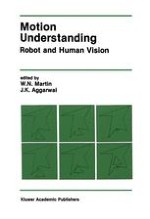1988 | OriginalPaper | Buchkapitel
Algorithms for Motion Estimation Based on Three-Dimensional Correspondences
verfasst von : S. D. Blostein, T. S. Huang
Erschienen in: Motion Understanding
Verlag: Springer US
Enthalten in: Professional Book Archive
Aktivieren Sie unsere intelligente Suche, um passende Fachinhalte oder Patente zu finden.
Wählen Sie Textabschnitte aus um mit Künstlicher Intelligenz passenden Patente zu finden. powered by
Markieren Sie Textabschnitte, um KI-gestützt weitere passende Inhalte zu finden. powered by
The goal in the motion estimation problem is to determine the transformation between two three-dimensional positions of a rigid body that is undergoing some arbitrary motion. Throughout this discussion it will be assumed that it is possible to acquire three-dimensional positional information of points located on the rigid body at two separate time instances. This may be accomplished through the use of a stereo camera setup (Barnard and Fischler, 1982). Alternatively, three-dimensional positional data can be obtained explicitly from a laser range finder. In general, points selected from the rigid body will tend to correspond to special geometrical features, such as corners or identifiable surface markings, and must often be extracted by special low level processing tasks (Gu and Huang, 1984). Such feature points will be invariant to the particular position sensing techniques used, and thus may be reliably located independent of object position and orientation.
